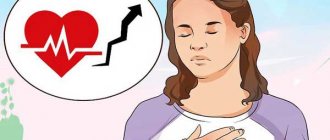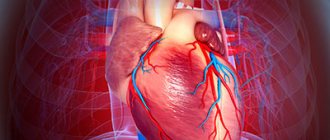Shortness of breath (dyspnea) is a painful feeling of lack of air, in extreme terms taking the form of suffocation.
If shortness of breath occurs in a healthy person against the background of physical activity or severe psycho-emotional stress, it is considered physiological. Its cause is the body's increased need for oxygen. In other cases, shortness of breath is caused by some disease and is called pathological.
According to the difficulty of the inhalation or exhalation phase, shortness of breath is distinguished as inspiratory and expiratory, respectively. A variant of mixed shortness of breath with limitation of both phases is also possible.
There are several types of shortness of breath. Dyspnea is considered subjective if the patient feels difficulty breathing, dissatisfaction with inhalation, but this cannot be measured and there are no factors for its occurrence. Most often it is a symptom of hysteria, neurosis, and thoracic radiculitis. Objective shortness of breath is characterized by a violation of the frequency, depth of breathing, duration of inhalation or exhalation, as well as increased work of the respiratory muscles.
Types of shortness of breath
During significant physical exertion, the body does not have enough oxygen, so usually in such cases the breathing rate increases. This is the so-called physiological shortness of breath
. However, if shortness of breath occurs with light exertion or at rest (for example, in a lying position), then its nature is pathological.
It is of great importance which stage of breathing causes difficulty - inhalation or exhalation. Shortness of breath that occurs during inspiration is called inspiratory dyspnea
, on exhalation -
expiratory shortness of breath
. Mixed shortness of breath is also common, in which both inhalation and exhalation are difficult.
Danger of the condition and how it arises
Tachycardia, which is accompanied by shortness of breath, indicates serious disturbances in the functioning of the body. Typically, these signs occur with coronary artery disease or heart failure.
The pathology is accompanied by shortness of breath or dyspnea, which worsens during physical activity. Increased heart rate occurs due to the inability of the heart to fully provide blood supply to the body.
Ischemia is manifested by tachycardia, since in this disease the patency of the coronary arteries is impaired due to atherosclerotic changes.
Similar symptoms are observed with vegetative-vascular dystonia, myocardial infarction, stroke, and panic attack.
All these pathologies pose a serious danger to human health and life. Hemodynamic disturbances increase the risk of blood clots and disrupt the functions of all internal organs.
If a strong heartbeat and breathing difficulties appear during stress, the use of drugs, or physical activity, then the matter is due to physiological factors. Elderly people often suffer from this. To improve your well-being, it is enough to normalize your lifestyle.
Causes of shortness of breath
Shortness of breath is caused by various reasons. The most common causes of shortness of breath are:
- diseases of the cardiovascular system
. Cardiovascular pathologies lead to insufficient blood circulation. The organs do not receive the required amount of oxygen, and carbon dioxide accumulates in the blood. The body reacts to this condition by breathing faster - more air is pumped through the lungs per unit of time. Shortness of breath due to cardiac pathology occurs or worsens after physical exertion or while lying down. In a sitting or semi-sitting position, shortness of breath goes away. This type of shortness of breath is characterized by difficulty breathing; - pathologies of the respiratory system
. Shortness of breath may be caused by obstructions to the passage of air through the respiratory tract, for example, by narrowing of the lumens of the bronchi. Therefore, shortness of breath is a typical symptom of bronchial asthma. In this case, exhalation is difficult. Shortness of breath can also be caused by a decrease in the respiratory surface of the lung tissue. As a result of such a decrease, in order to maintain the required amount of oxygen entering the blood, more intensive work of the lungs is required, that is, more frequent inhalation. The list of diseases of the respiratory system in which shortness of breath may occur is extensive and includes such dangerous pathologies as tumors, pneumonia, chronic obstructive pulmonary diseases and others; - anemia
. A lack of red blood cells (erythrocytes) and hemoglobin leads to the fact that even with normal functioning of the heart and lungs, the blood is not able to provide the organs with the necessary amount of oxygen, and the body tries to compensate for this by increasing the breathing rate; - neuroses and panic attacks
. In this case, a clinical examination does not reveal pathologies of the heart and lungs, but subjectively the patient experiences a lack of air, and psycho-emotional changes lead to increased breathing. - Obesity and diabetes also often lead to shortness of breath.
Diagnosis of dyspnea
After a conversation, to establish the exact causes of frequent shortness of breath, the doctor will prescribe a number of additional diagnostic procedures, as well as laboratory and functional tests. For complaints of dyspnea, the following are recommended:
- Spirometry. Allows you to quickly assess all key parameters of the respiratory system.
- Assessment of carbon monoxide (CO) content in exhaled air;
- Bronchodilation test. It is carried out to diagnose bronchial asthma or COPD, which can cause asthma attacks.
- X-ray examination. Recommended for suspected lung tumors or emphysema.
- MRI, CT. Allows you to clarify the diagnosis made after radiography. The size and location of the affected areas of the lungs are accurately determined.
- Laryngoscopy. Necessary to check the upper respiratory tract for the presence of foreign objects that impede breathing.
- ECG. Prescribed for suspected cardiac pathology. In case of significant rhythm disturbances and changes in the myocardium, ultrasound with Doppler is supplemented.
- Clinical blood test. Needed to determine the ESR, the number of leukocytes to identify the inflammatory process.
Treatment of shortness of breath depends on its cause , so the diagnostic stage is extremely important. Without instrumental and laboratory studies, it is impossible to establish the factors that provoke the symptom. Taking medications in this case will be unreasonable and ineffective.
Treatment of shortness of breath
Shortness of breath is not an independent disease, but a symptom indicating a malfunction of certain organs. To make it easier to diagnose the disease, before visiting a doctor, try to answer the following questions:
- When did you notice that shortness of breath appeared?
- Does shortness of breath always occur after physical exertion, or does it bother you even at rest?
- What is more difficult - inhaling or exhaling?
- In what position does it become easier to breathe?
- What other symptoms bother you? This may include chest pain, swelling, weakness, dizziness, cough, and fever.
When to see a doctor?
If it becomes difficult to breathe while lying down, this is an alarming symptom, and you should not delay consulting a doctor. In order to diagnose the disease in time and begin treatment, it is important to contact a pulmonologist, cardiologist or therapist as early as possible. The doctor conducts an examination and, if necessary, refers to other specialists. Based on diagnostic data, a treatment regimen is drawn up.
References
- Klyushnikov S.A. et al. Clinical case of Pompe disease with late onset //Nervous diseases, 2015. No. 2.
- Sukhorukov V.S. et al. Diagnosis of Pompe disease // Russian Bulletin of Perinatology and Pediatrics, 2010. T. 55. No. 6.
- McGee S. Evidence-based physical diagnosis e-book. – Elsevier Health Sciences, 2012; p.145-155.
- Radiation methods for diagnosing heart disease / Manfred Thelen, Raimund Erbel, Karl-Friedrich Kreitner, Jörg Barkhausen; lane with him. ; under general ed. prof. V.E.Sinitsyna. – M.: MEDpress-inform, 2011. – 408 p. : ill.
- Belovol A. N., Knyazkova I. I., Gridasova L. N. Diagnosis of chronic heart failure in patients with chronic obstructive pulmonary disease // Scientific bulletins of Belgorod State University. Series: Medicine. Pharmacy, 2014. T. 28. No. 24 (195).
- Chuchalin A.G. Pulmonary edema: treatment programs //Practical Pulmonology, 2005. No. 4.
- Frolova E. B., Yaushev M. F. Modern understanding of chronic heart failure // Bulletin of modern clinical medicine, 2013. T. 6. No. 2.
- Pompe Disease More Common Than Previously Believed, Experts Say. Pompe Disease News. URL: https://pompediseasenews.com/2019/05/08/pompe-disease-more-common-than-previously-believed-experts-say/ (accessed 09/13/2019).
- Shchukina S.V. et al. Frequency and degree of shortness of breath in patients with ankylosing spondylitis // Siberian Medical Journal (Irkutsk), 2007. T. 74. No. 7.
GZEA.PD.18.09.0435q
FAQ
Which doctor should you contact if you notice signs of shortness of breath?
First of all, you need to make an appointment with a therapist. He will issue directions for primary tests and diagnostic studies. Based on the results obtained, it will become clear which specialist to refer the patient to. Most often, further treatment is carried out by cardiologists, pulmonologists and neurologists.
Can pregnant women experience shortness of breath? Is it dangerous for the fetus and mother?
Shortness of breath during pregnancy is observed quite often. This is due to constriction of the lungs by the diaphragm. The fetus is constantly growing, the load on the heart and lungs increases. Therefore, shortness of breath should not be considered a danger in this case. The normal respiratory rate in pregnant women is 22-24.
How to deal with systematic shortness of breath?
Of course, you need to understand the reasons for its appearance in the first place. If shortness of breath is not associated with serious illnesses, but is only a consequence of physical weakness of the body (perhaps after an injury or a long-term serious illness), then evening walks in the fresh air will help. You can get a dog, which will become an additional incentive for physical activity and walks.
Breathing exercises
Your nurse can show you how to take slow, deep breaths to help relieve shortness of breath. You can do them with the diaphragm, the muscle that separates the chest cavity from the abdominal cavity (see Figure 1). This type of breathing is called diaphragmatic breathing.
Figure 1. Aperture
Try to relax while doing breathing exercises. Relieve muscle tension. This will allow the abdominal cavity (belly), chest, and lungs to expand.
Here are some breathing exercises that can help relieve shortness of breath.
Deep breathing 4-8-8
This exercise improves the movement of air in the lungs. This helps increase oxygen levels throughout the body.
- Inhale through your nose, counting to 4.
- Hold your breath and count to 8.
- Exhale through pursed lips (as if you were whistling) for a count of 8.
- Repeat 4 times.
Chest wall stretch
This exercise will help the chest muscles become more elastic.
- Inhale through your nose, counting to 4. As you inhale, extend your arms in front of you and raise them above your head.
- Exhale through pursed lips. As you exhale, open your palms and lower your arms down to your sides.
- Repeat 4 times.
Rapid breathing through the nose
This exercise can help strengthen your diaphragm.
- Shut your mouth.
- Inhale and exhale quickly through your nose for 15 to 30 seconds.
- Practice this exercise several times until you can do it for 60 seconds.
Walking and breathing
These tips will help you breathe easier when walking.
- When walking on a level surface, inhale and exhale through your nose without opening your mouth.
- On inclined surfaces (slopes), inhale through your nose and exhale through pursed lips.
- When climbing stairs, exhale at each step through pursed lips.
Recovery from an attack of shortness of breath (from coughing or exercise)
- Tuck your chin to your chest.
- Take 10 short and sharp exhalations through your mouth. If necessary, take short breaths between them.
- When your neck muscles relax a little, inhale through your nose.
- Exhale 3 times through pursed lips. Inhale between exhalations.
- Inhale through your nose, counting to 4.
- Exhale through your open mouth, counting to 8 and making the sound “ah”.
- Repeat 3 times.
to come back to the beginning
Nocturnal shortness of breath in bronchial asthma
The feeling of lack of air that develops in a patient at night can be a sign of not only cardiac, but also “ordinary” bronchial asthma - an allergic disease manifested by attacks of spasms of the small airways.
As a rule, during these attacks, shortness of breath quickly increases and is soon replaced by suffocation, which requires immediate use of bronchodilators. However, sometimes symptoms are expressed only as shortness of breath or only as episodes of dry cough.
Attacks of bronchial asthma can occur both during daylight hours and during the night. The frequency of daytime and nighttime attacks is necessarily taken into account when establishing the severity of the disease. With an optimal treatment regimen, the patient should not experience either daytime or nighttime symptoms, so if, against the background of the therapy prescribed by the doctor, a person regularly experiences attacks during the day or, especially, during sleep, he should consult a pulmonologist to clarify the type of severity illness and adjusted treatment.
3. Symptoms and diagnosis
Shortness of breath at rest - i.e. in a relaxed state, outside of physical activity, during sleep or rest - can manifest itself in different ways and be accompanied by various additional symptoms, which is determined by the root cause of respiratory disorders.
Thus, cardiovascular dyspnea is accompanied by tachycardia, cyanosis, coldness and swelling of the extremities; patients complain of the inability to “take a deep breath” and frequent attacks of “night suffocation.” Against the background of such attacks, whether at night or during the day, life-threatening conditions often develop.
Pulmonary dyspnea is characterized by chest pain, weakness, drowsiness, low-grade fever, cough, and asthmatic-type breathing difficulties. However, these, as well as many other symptoms, appear in various combinations, since they depend on specific causes and diseases (infectious, obstructive, oncological, and many others).
Central neurogenic dyspnea usually manifests itself as sharply rapid shallow breathing, “linked” to a specific type of stressful situations.
Hormonally caused shortness of breath is often caused by the release of adrenaline during intense experiences of fear, anxiety, and excitement.
Diagnosis and qualification of resting dyspnea requires auscultation and percussion examination of the chest, external examination, careful study of complaints and anamnesis, laboratory blood tests (clinical, biochemical, hormonal, gas composition analysis, etc.), radiographic or tomographic examination. Depending on the suspected causes, spirometric (respiratory) and cardiological tests (ECG, EchoCG, treadmill test, bicycle ergometry, Holter monitoring, etc.), consultation and examination with a neuropsychiatrist, endocrinologist, nephrologist and other specialists are prescribed.
About our clinic Chistye Prudy metro station Medintercom page!









